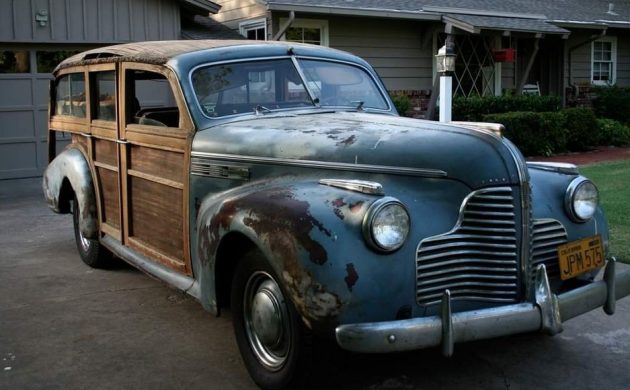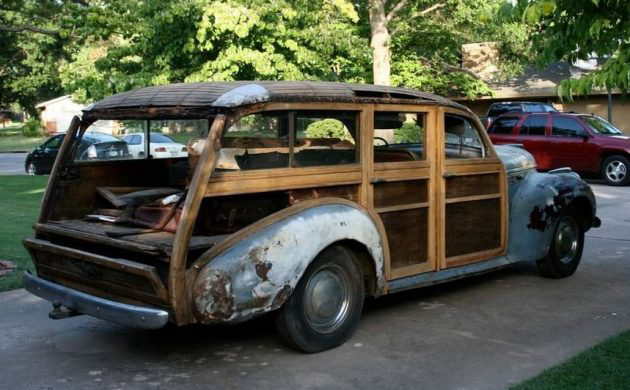Rare Woodie: 1940 Buick Super Estate Wagon
One of the 495 Buick Super Estate Wagons manufactured for the 1940 model year for sale in the US (six others were made for export) has surfaced in Cleveland County, Oklahoma and here on Facebook Marketplace, the tip is brought to us by Channing W, whom we thank. Buick didn’t make wood bodies, so the original contract for producing the wood coaches was awarded to a small company in Reading, Pennsylvania, Biehl’s Auto Body Works. Biehl’s won the contract by way of a WWI friendship between a Buick engineer and Earl Biehl as soon as Buick’s president, Harlow Curtice, made the decision to go forward with the production run. The car was a winner and sold out the production run.
Buick made the chassis, drivetrain, fenders, and trim parts while Bielh made everything from the windshield/dashboard to the tailgate. The large front fenders were one piece–a pretty big advance in metallurgy and stamping capabilities once you assess the bulk and size of that fender. Looking closely at this picture, the wood coachworks was not merely a wood skin attached to a metal frame (like MG and other sports cars), but the wood panels and frame were the only things separating the interior of the car and the elements—akin to a 19th-century horse-drawn carriage coach. Biehl had a long history of making carriages and coaches since its 1820 founding. This photo also shows how the base of the roof was made: The ash trusses supported an interior ceiling while a “lath” like approach made the curves on the front, back and sides. The wood used by Biehl was Northern Ash for the frames (a hardwood famously known for its use in making baseball bats) and African Mahogany for the panels. The chassis is a 121 inch Buick Super wheelbase with a 248 c.i. valve-in-head “Dynaflash” straight eight. Sorry, no word from Seller whether the engine turns, runs, or is complete.
You’ve no doubt noticed that the Facebook post for this car is thin on details, comprised of only four exterior photos, one of which is this rear shot showing details of the wood planking for the floor and the bottom rear door. A larger upper door met the smaller lower door but the elements were not kind to the upper jamb where the hinges would be, it has rotted and broken off. Attempts to contact the seller for additional information and photos were not returned in time for this post. TO compare and contract, a number of 1940 Estate Wagons have been up for sale recently, one by RM/Sotheby’s which is a multi-meet award winner including an AACA “Best of the Best.” This was forecast to be sold in the $175,000 to 225,000 range (see the article here). Another Buick Super Estate is currently up for auction with RM Sotheby’s (online only), coming up for sale on November 19. See that listing here for comparison. The pre-auction price range is $52,000-60,000. Upon looking at the photos there, you can see the issues with that car compared to the previously mentioned award-winning car auctioned in 2017. Another 1940 Estate Wagon appears to be for sale in Sarasota, FL for $169,500 with 49,000 miles on it here.
This drawing and description by Biehl seen on the Coachbuilt website describe the Estate Wagon as having two doors on the passenger side and only one on the driver side with suicide doors shown on the passenger side. The final production models and selections of doors and choices of wood differ from these Biehl’s descriptions (see more details and history here). Afraid that Biehl’s could not keep up with higher production numbers for 1941, Buick awarded the coachbuilding to Hercules Body Company of Evansville, IN for 1941.
If you clicked on the other links inserted in this post, you no doubt found a story repeated about the chance late 1930s meeting of Harley Earl and Harlowe Curtice at a cocktail party in Beverly Hills with one socialite named “Bunny” McLeod—the legend is that meeting with her was how the Buick Estate Wagon came about. In a big ceremony at the Ambassador Hotel in LA, Buick gave Bunny the prototype of the 1940 Estate Wagon as thanks (and for a little publicity). AS for our subject car pictured here, seller Jeffrey Wiggins is asking $40,000 for this rare mix of the very modern in horseless carriage design by Buick and the superb wood craftsmanship of horse-drawn carriagemakers. Drool, all you cabinetmakers worldwide!
Auctions Ending Soon
 1969 Ford MustangBid Now17 hours$1,050
1969 Ford MustangBid Now17 hours$1,050
 1965 Ford Falcon Station WagonBid Now3 days$2,300
1965 Ford Falcon Station WagonBid Now3 days$2,300
 2002 Jaguar XK8 ConvertibleBid Now4 days$4,250
2002 Jaguar XK8 ConvertibleBid Now4 days$4,250
 1979 Chevrolet Camaro Z/28Bid Now5 days$4,500
1979 Chevrolet Camaro Z/28Bid Now5 days$4,500
 1960 Dodge D300Bid Now5 days$300
1960 Dodge D300Bid Now5 days$300







Comments
As much as I love woodies, it’s a good thing wood floats because you’re gonna be quickly underwater at that price…
$40.000.00 for what amounts to a junk yard reject???? Add another $40 to
$50,000.00 in reconstruction costs and you MIGHT have something comparable to the others demonstrated. Oh, and a frame-off reconstruction.
I don’t think much of the crumby plywood replacement door cards (door boards?) on that Southeby’s example. A sloppy job of restoration indeed.
Both Buicks selling through Sotheby’s have the correct wood for door cards. Nothing crumbly or cheap about them that I can tell. Correct for Biehl bodies.
My thought was that the door boards chosen for the $50-60k Sotheby’s auction were red OAK and did not fit with the mahogany door panels I’ve seen in nearly every other Estate Wagon.
Also, need to look carefully at the window line–I think it is something worth attempting to get that line from the front door to the rear perfectly straight. Look at the $175k and the $169k versions. . .straight true and normal. I think there can be some sag if the wood side panels are slipping, partly rotted or for any other number of reasons. The trick is to get the window line straight and the grains in the mahogany side panels parallel to the window line.
Yeah, I also noticed that. I thought such amateurist should be a warning of everything else done on the vehicle.
As a Buick woodie owner who restored his from the ground up I can tell you that had I not had the skills and patience to tackle the woodwork and steel bodywork myself I would have gone underwater. These are very expensive to restore. That being said, This very rare 1940 wagon would be a superb vehicle when finished and nearly all the wood is there for either restoration or templates. However it looks like the upper and lower rear gates are gone. Not the worst of problems. The buyer will need to join the National Woodie Club and get in contact with other 1940 owners. The tricker issue if the unique locking hardware that was mounted to these gates. THAT will be tough. As far as price, $40k is a bit steep. It will probably go for $25k to $30k since the buyer is looking at $80k to $100k to restore it.
Actually, I originally thought neighborhood of
Stephen – – – Actually, I originally thought neighborhood of $90K for restoration but was unsure, so made guess of $40K to $50K. I made that guess supposing a professional with proper skills doing all – or most – of the work personally as you did.
490K
I was thinking $40 for the car (just sayin’) + rebuild the cabin to spec at $30 (my own tools and locally milled ash, imported mahogany + 20,000 hours) + $30 for chassis and engine + $20 for finish, paint, interior seats.
$120k and by the time I complete this, I will be divorced, living in the car and it will be worth $120k. That’s a great deal right there.
Still want it.
Only an enthusiast on Jay Lenos level could afford to buy at this price and then restore it.
This would be a good project for some Amish carpenters to tackle, they’re great at restoring carriages, etc. just a thought.